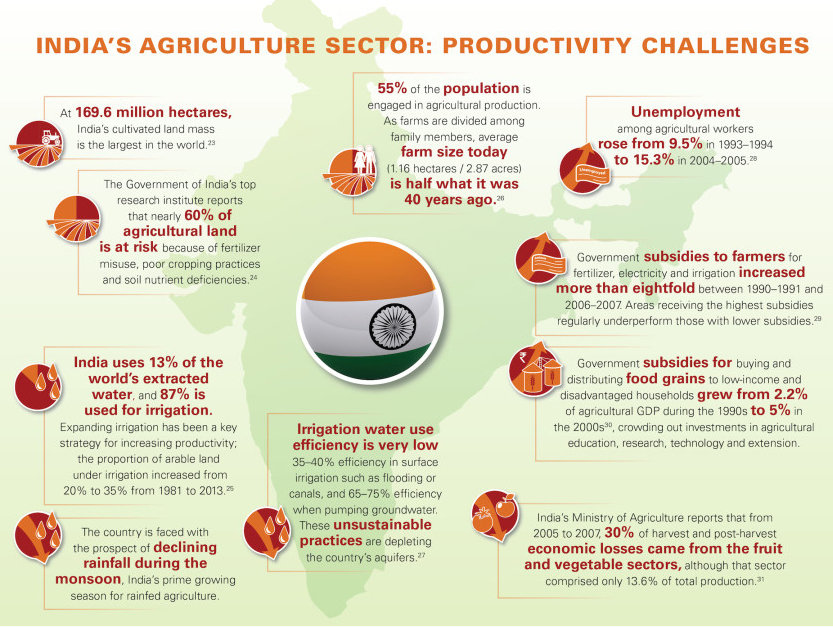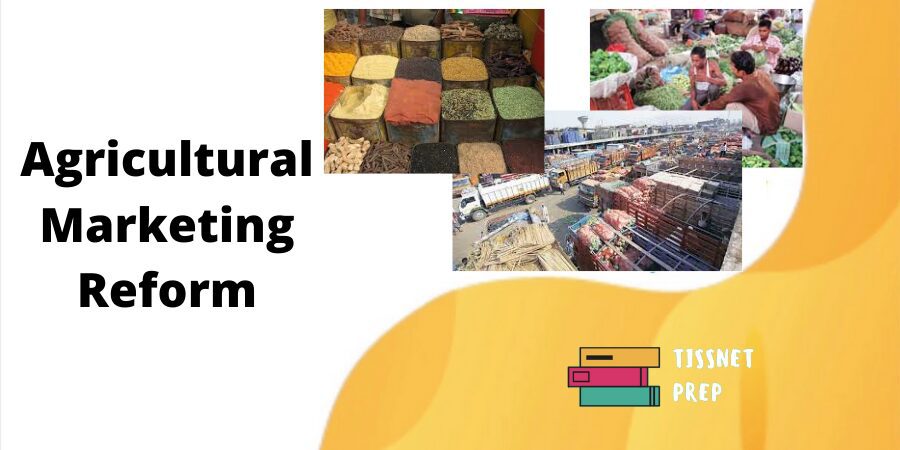In order to revive the Indian economy, the Centre government has announced the Atma Nirbhar Bharat Abhiyan. As a part of it, the plan also focuses on bringing farm sector reforms.
It includes the announcement of Rs 1-lakh crore fund to finance agriculture infrastructure projects at the farm gate and produce aggregation points. Also, Rs 500 crore has been allocated to extended Operation Greens which comprises Tomatoes, Onion and Potatoes (TOP) to ALL fruits and vegetables (TOTAL).
Apart from it, the government has also shown the intention to usher in agricultural marketing reforms. These reforms relate to amending the Essential Commodities Act (ECA), 1955, bringing a Central legislation to allow farmers to sell their products to anyone, outside the APMC mandi yard and creating a legal framework for contract farming.
These reforms are long overdue and if implemented, can go a long way in building efficient value chains and ensuring better returns for farmers.
Issues in Agricultural Marketing
Despite significant progress in food security, the farmers’ income remains subdued owing to the infrastructure deficit in agricultural supply chains. This combined with the nature of agricultural marketing laws in India, farmers suffer more in marketing their products than during the production process.
Essential Commodities Act (ECA), 1955
- The ECA has been used by the Government to regulate the production, supply and distribution of a whole host of commodities it declares ‘essential in order to make them available to consumers at fair prices.
- The ECA gives consumers protection against irrational spikes in prices of essential commodities. However, it has acted against the interest of the farmers.
- This has thwarted the creation of integrated value chains across the country.
- ECA has its roots in the Defence of India Rules of 1943, when India was ravaged by famine and was facing the effects of World War II.
- It was scarcity-era legislation.
- By the mid-1960s, hit by back-to-back droughts, India had to depend upon wheat imports from the US and the country was labelled as a “ship to mouth” economy.
- However, today, India is the largest exporter of rice in the world and the second-largest producer of both wheat and rice, after China.
- Due to these factors, the Economic Survey 2020, has recommended repealing this “anachronistic” Act.
Working of ECA
- If the Centre finds that a certain commodity is in short supply and its price is spiking, it can notify stock-holding limits on it for a specified period.
- The States act on this notification to specify limits and take steps to ensure that these are adhered to.
- Anybody trading or dealing in a commodity, be it wholesalers, retailers or even importers are prevented from stockpiling it beyond a certain quantity.
- Also, the traders have to immediately sell into the market any stocks held beyond the mandated quantity.
- Thus, the Government has invoked the Act umpteen times to ensure adequate supplies and cracked down on hoarders and black-marketeers of such commodities.
- Given that almost all crops are seasonal, ensuring round-the-clock supply requires an adequate build-up of stocks during the season.
- As, it may not always be possible to differentiate between genuine stock build-up and speculative hoarding.
- Further, with too-frequent stock limits, traders also may have no reason to invest in better storage infrastructure.
- Also, food processing industries need to maintain large stocks to run their operations smoothly. Stock limits curtail their operations.
- In such a situation, large scale private investments are unlikely to flow into food processing and cold storage facilities.
- Due to lack of storage facilities, when farmers bring their produce to the market after the harvest, there is often a glut, and prices plummet.
- All this hurts the farmer.
- In the lean season, prices start flaring up for the consumers.
- So, both farmer and consumer lose out because of the lack of storage facilities.
APMC Act
- In the majority of the states, under the APMC acts, farmers are required to sell a large number of commodities in a local mandi where intermediaries often manipulate the price.
- Thus, APMC markets have become monopsonistic (too many sellers and one buyer) with high intermediation costs.
Working of APMC
- In most APMCs, buyers have to route all purchases through licenced arhatiyas(middlemen).
- These middlemen charge a commission for their “services” — many times, both from the buyer and seller.
- The arhatiyas are often a moneylender, supplying seeds, fertilisers and pesticides to farmers on credit. They, then, are forced to sell through him and settle their dues in perpetuity.
- Also, mandi fees range from 0.5% to 5% on the value of the sale, while varying across states and commodities.
- Further mandi fees on inter-state trade amount to double taxation, besides violating the idea of a single national market.
- Distress sale due to lack of storage infrastructure.
- At mandis the lowest prices are during the 3-4 post-harvest months and highest in the immediate pre-harvest period.
- Farmers undertake maximum sales just after harvest, as they need to purchase inputs for the next sowing season.

Effects of These Reforms
Amending ECA
- The dismantling of such controls under ECA would expand India’s agri-exports and enable private investment in supply chains.
- This could facilitate private investment in the food processing industries, strengthening the farm-to-fork chain, and benefiting both producers and consumers.
Dismantling APMC Monopoly
- The proposed Central law to allow farmers to sell to anyone outside the APMC yard, may bring greater competition amongst buyers, lower the mandi fee and the commission for arhatiyas (commission agents) and reduce other cesses that many state governments impose on APMC markets.
- Further, by removing barriers in inter-state trade will help farmers in the regions with surplus produce to get better prices and consumers in regions with shortages will have availability of agri-products at lower prices.
- Thus, India will have one common market for agri-produce, enabling efficient supply chain.
Legal Environment for Contract Farming
- Contract Farming will provide an assurance of a price to the farmers at the time of sowing.
- This may help them take cropping decisions based on forwarding prices.
- Also, the new system will minimise their market risks and may solve the issue of food shortages.
Conclusion
There are many existing laws like Model Agricultural Produce and Livestock Marketing (promotion and facilitation) Act, 2017, electronic national agriculture market (eNAM), Model Contract Farming Act, 2018 and Model Agriculture Land Leasing Act, 2016, which seeks to address the many problems, as intended by current reforms.
However, agriculture being a state subject, hinders the materialisation of these reforms on the ground. Therefore, in order to make India’s farmer truly Atmanirbar (self-reliant), there is a need to follow the ethos of cooperative federalism.

